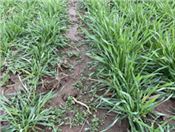Wheat, Triticale And Cereal Rye Varietal Differences In Cover Crop Potential

The wheat variety on the right had substantially more fall/winter biomass accumulation than the variety on the left.
BILL BRUENING
LEXINGTON, KENTUCKY
Winter small grain crops, such as wheat, barley, cereal rye, canola, oats and triticale are an important part of Middle-America’s agricultural economy and also serve as winter cover crops. Cover cropping is an important component of sustainable agricultural practices. Cover crops reduce soil erosion, add organic matter to the soil, provide moisture conserving residues and reduce ground water contamination by utilizing residual fertilizer from the previous crop.
Cereal rye is known for its robust fall growth and is used for cover cropping. Wheat however, is more commonly used or serves as a cover crop because seed is readily available and it is a major grain crop.
Triticale is a cross between wheat and cereal rye and has good cover cropping potential, but its use is less common.
In 2021, the University of Kentucky Small Grain Variety Testing Program evaluated the cover cropping potential of wheat, triticale and cereal rye varieties. There were 11 cereal rye, 11 triticale and 84 wheat entries planted October 23, 2020, in Lexington, KY. Cover crop potential was an estimate of the amount of leaf biomass (plant canopy) accumulated during the fall and winter growing periods and measured on January 22, 2021 using the Canopeo app. Higher levels of winter biomass, provide greater levels of protection from erosion and foster the other fore mentioned benefits of cover cropping.
The trial showed that cereal rye averaged 44 percent canopy coverage and ranged 32–59 percent among varieties. Triticale varieties averaged 32 percent canopy coverage and ranged 20–51 percent. Wheat varieties averaged 19 percent canopy coverage and ranged 8-35 percent among varieties.
The results indicate that cereal rye and triticale have superior cover cropping potential over wheat in terms of fall/winter biomass accumulation. Triticale and cereal rye seed is however, often limited in availability. Wheat is a primary winter crop and seed and varietal choices are widely available. The results also indicate that for each crop, there is a wide range in genetic differences in fall/winter biomass accumulation among varieties. Wheat varieties with high cover crop potential (Image 1) have similar fall/winter growth with average triticale varieties. For wheat producers, use of high grain yielding varieties with high cover cropping potential allows growers to benefit from maximizing short term grain production profitability while utilizing sustainable practices for the future. The results of this trial are available at http://www2.ca.uky.edu/agcomm/pubs/PR/PR796/PR796.pdf . ∆
BILL BRUENING: Research Specialist, University of Kentucky